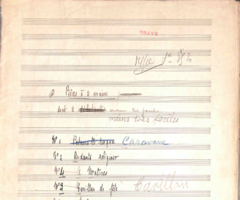Pièces à quatre mains pour piano (dont deux mains très faciles)
Caravane – Andante Religioso – Carillon de Fête – À Matines – Habanera – Minuit sonne à la Grosse Horloge
In later years Mel Bonis abandoned the musical genres that had interested her before the First World War and turned instead essentially to works of religious inspiration (for organ or choir) or compositions for the musical education of children, especially her own grandchildren. Encouraged by the success of her Album pour les tout petits (1913), she went on to publish (Éditions Eschig) Dix-sept Pièces enfantines (1926), Miocheries (1928), Six Pièces à quatre mains (1930) and Neuf Pièces faciles (1936). The pieces of 1930, now her Opus 130, stand out from the other sets in their compositional style and in the fact that they are for piano four hands. The aim here is to teach individual playing, with each piece offering a new technical difficulty, and at the same time enable the child to learn the basic principles of playing with a partner: how to listen to the other player and how to keep to the same rhythm. For each piece, Mel Bonis indicates the parts for “l’élève” which, as the title states, are very easy, and those for “le maître”, which are much more elaborate. This approach ensures that the beginner is not confined to works that are too basic and is able to hear the subtleties offered by the instrument while participating. Whether playing at the lower end of the piano (Caravane, Habanera, Minuit sonne à la Grosse Horloge) or the higher end, the student is given a single formula which is repeated ostinato throughout the piece. As their titles indicate, the pieces are alternately “exotic” or religious in mood.

